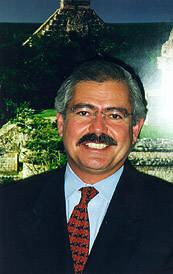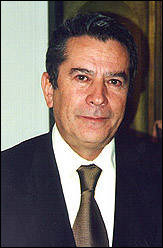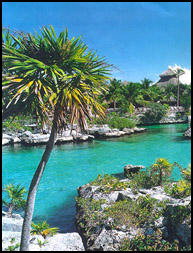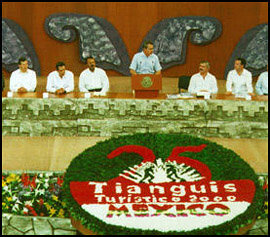 Tourism:
Mexico´s Backbone Tourism:
Mexico´s Backbone

On a global level, Mexico ranks 7th in terms of international visitors it attracts, making it the leader in Latin America. Sitting on the laurels of the nation's natural assets, tourism, the second most important national bread-World Investment News Ltdr after manufacturing, still has hectares to grow. Mexico is blessed not only with the natural beauty of two ocean-abutting coasts, but also less-traversed rich jungles, famed canyon passages, pine-covered mountain stretches, quaint colonial villages, not to mention a plethora of archeological attractions. Though most of the foreign participation in developing the industry has focused on beach-front properties, others are discovering opportunity in the hidden paths to recently uncovered Aztec ruins, eco-tourism ventures and pueblos not on the map.
Most of Mexico's 19.8 million visitors come from the United States and Canada, and Minister of Tourism Oscar Espinosa Villareal hopes increased trade with the EU will also bring more Europeans to visit, whether it be business or pleasure. The Tourism ministry will begin promotions to foment interest in discovering Mexico's natural assets, targeting the EU, with hopes of varying the market. This year, a 15-20% increment of European visitors is already expected. Airport privatizations and thus investments in the sector are also expected to raise eyebrows abroad, especially since concession World Investment News Ltdrs include many Europeans. The sector raked in $1.4 billion last year, and expects a 15-20% increase to end this year. Sustained growth and promising profitability are now a reality with legal certainty, financial liberalization, legislative flexibility and free repatriation of capital. Fonatur , the National Trust Fund For Tourism Development, has been a key factor behind successful development of tourist towns, in charge of overseeing that development is sustainable, and that it abide by federal and state laws. As Mexico's still young tourism engine started to rev up, the government realized its potential and made it a priority to foment increased but measured growth. Fonatur was appointed 25 years ago to construct the basic infrastructure for first-class tourist destinations, plan a medium- to long-term sustainable urban development in these fast-spreading areas, and while doing so, protect the environment, says Fonatur CEO Alfredo del Mazo Gonzalez .

The agency masterminded integrated sites like Cancun, Los Cabos, Huatulco, Ixtapa, Loreto and Barranca del Cobre. These well-planned sites have reaped their fruits, seeing a growth rate of 11.7%, compared to the national average of 7.2%.
The sun-and-sand business continues to be first rate in Mexico, but competition for investment with other segments, like eco-tourism and adventure vacations, construction of infrastructure to reach archeological sites and rural towns, or crystal clear rivers, is beefing up, revealing the constant metamorphosis of the sector. Fonatur is largely responsible for expanding and making the nation's historic ruins tourist-friendly. In the state of Chiapas, the well-preserved ruins of Palenque lie near countless other attractions, like the Agua Azul waterfalls, and other Mayan ruins at Bonapak, Tonin, etc. In Baja California, a monumental marine project is taking shape, called "Nautic Net." It will comprise 21 ports every 120 miles along the coast from the Sea of Cortez to the Peninsula of Baja California, and expects to attract marine activity from Arizona to California. The potential is large, says Fonatur's Del Mazo, and the present boat traffic of 8,000 per year is expected to increase to between 70,000 to 80,000.
One of the highest priorities on the government’s agenda is the promotion of private investment, which the Mexican government is adopting in its tourism policy, emphasized Hector Flores Santana , the Under-secretary of Tourism Development. He also added that at this moment Mexico has enormous investment potential for creating golf courses, marinas, tourism residencies and time-share. An umbrella agency that encompasses both federal, state and private industry is the Mexican Council for the Promotion of Tourism. Created just last year, it is expected to be a driving force behind a well-managed industry that undertakes all of its potential. It includes the participation of three federal agencies, the Finance Ministry, the Tourism Ministry and Fonatur, also, the eight states that figure the most in tourism, 14 private sector organizations and 15 from the public sector. Besides playing an important role in Mexico, the council will set up representation in major foreign cities, to attain an integrated coverage of promotion. Last year, only $20 million was spent for promotion, which is little compared to most booming tourist resorts, like Puerto Rico, which spends $75 million annually. The council should change that, however, allotting a wider financial capacity this year with its worldwide promotion plan for Mexico. Promotional multi-destination programs include "The heart of Mexico," which comprises the six states surrounding Mexico City, "Mundo Maya," which foments growth in the southern peninsula where the majority of Mayan ruins are located, and "Northern Border," to aid the image of the states that share boundaries with the U.S.
|

The fast-growing sector has been a windfall for the hotel industry, another strong sector attracting private capital, and with room to grow. The growth-rate of hotels has not been able to meet demand created by recent plans to evolve national archeological sites to facilitate tourists. The Mayan corridor, stretching from Cancun to Tulum, for instance, is still being developed. Hotel occupancy in the region hovers around 80-90%, making it very lucrative, and Espinosa says the market is begging for more accommodations. The Under-secretary for Tourism Promotion, Elias Rivas Torres , claims there are 400,000 hotel rooms in all of Mexico, which are rated on a system of stars or diamonds on a scale of 1 to 5, 5 being the best. Many hotels in Mexico pertain to the 4-5 range, meeting the demanding needs of both leisure and business travelers. In Mexico City, Hotel Intercontinental and Hotel Nikko are preferred accommodation destinations for business travelers, that will find the hotels conveniently located in the Polanco district, and business centers within the hotels to work away from their office.
 Tianguis
Tourism Fair: 25th Anniversary, Acapulco Tianguis
Tourism Fair: 25th Anniversary, Acapulco

The famous annual "Tianguis Turistico" is celebrating its 25th anniversary this year. This tourism trade show held in Acapulco succeeds in convincing investors year after year that Mexican tourist hot-spots are a secure long-term offering. Attended by the creme de la creme of deep-pocketed investors, top government officials, and industrial businessmen, the Tianguis provides a forum for serious deals to go down. The beach scene, overwhelmed with rising demand from the upscale business and pleasure sector is still teeming with opportunities to develop more golf courses, seaside marinas, restaurants, spas, amusement centers and malls. Regardless of the specifics of each sector, tourism continues to hold an advantage over other industries, because it charges and collects in dollars.
At one time perhaps the best-known tourist site in Mexico, Acapulco's heyday has passed, and it is looking for ways to renovate itself. Only a three-hour drive from Mexico City, the city with almost perfect climate year-round is still the preferred vacation spot of locals. But even old-favorites sometimes need a facelift. The city is being modernized, says State of Guerrero Governor Rene Juarez Cisneros . Las Brisas Acapulco has traditionally been the leading resort and continues to set the highest hotelier standards. "Las Brisas has and will always be a hotel for couples, we market it in many areas as a honeymoon destination. Las Brisas is a destination by itself although it is in Acapulco, it remains as an individual outright destination", explained the President and General Director Juan de Pablos .

New upscale areas are being developed, namely Punta Diamante and La Cima, and highways are being refurbished. Ixtapa has stolen some of the market of its sister city Acapulco, and lured those vacationers who prefer a little less crowded beach. Part of the state's diverse geography, Governor Juarez says it is an ideal site for long-term investment, and is equipped with modern hotels and infrastructure necessary to do business. The state of Guerrero is making strides to continue capturing capital, and offers an attractive zero rate tax incentive and infrastructure for the long-term investor. Aside from tourist destinations like Acapulco, Ixtapa and colonial city Taxco, its mining, textile and agriculture sectors are booming.
Taxco, well-known as the "silver city", has a long history with the silver mining industry, and still offers the best variety of silver artifacts and jewelry in the country. Silver and zinc are still mined in the state, with four major projects underway, and the potential for more. Companies from Japan, Canada and Mexico have a hand in the projects, and a U.K. firm is looking to get involved. Guerrero's fertile land and excellent irrigation make it the manger of the agro-industry. |

